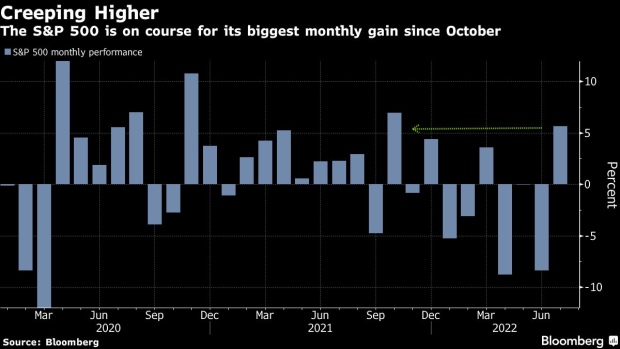Jul 22, 2022
BofA Says Stock Outflows Are Yet to Reflect Investor Pessimism
, Bloomberg News

(Bloomberg) -- Outflows from global equity funds are only just starting to catch up with investor pessimism on risk assets, according to Bank of America Corp. strategists.
“Everyone is bearish but no one has sold,” strategists led by Michael Hartnett wrote in a note, adding that for every $100 of inflows since January 2021, just $2 have flowed out from tech stocks and $3 exited from equities overall.
“Flows are starting to catch up with sentiment,” Bank of America strategists said, warning that stocks will likely see more declines as they don’t think “Wall Street unwinds financial excesses of past 13 years with a six-month garden variety bear market.” Bearish positioning, according to Hartnett, is currently the top factor for risk appetite and possible market recovery, but corporate profits and hawkish monetary policy don’t yet signal a new bull trend.
In the week through July 20, global equity funds had outflows of $4.5 billion, with US stocks seeing a second week of redemptions at $0.7 billion, according to the note citing EPFR Global data. About $8.2 billion left bonds -- the first outflow in three weeks, while cash saw inflows of $3.5 billion, the data show.
Equity markets have tried to recover in July, with the S&P 500 Index poised for its biggest monthly gain since October 2021, after concerns of a looming recession sent it tumbling into a bear market last month. Still, investor sentiment remains subdued as the Federal Reserve is expected to remain hawkish despite the possibility of an economic contraction as it fights historically high inflation.
Market participants are also debating whether stocks have seen full capitulation, with the July Bank of America global fund manager survey showing earlier this week that investor allocation to equities plunged to the lowest since October 2008, while exposure to risk assets dropped to levels not seen even during the global financial crisis. In the meantime, Sanford C. Bernstein strategists said stocks are yet to see full capitulation as equity outflows outside Europe have only just begun.
“Putin/China catalysts to be less bearish in the second half but bull run needs peak CPI, peak yields, Fed done by 2023, which is unlikely without big recession and/or big credit event,” said Hartnett, recommending to sell the S&P 500 at 4,200, or 5% higher from the latest close.
Investors are focusing on the earnings season for clues on whether companies will be able to overcome a flurry of risks, including surging inflation and supply constraints. Hartnett had said last week that weaker-than-expected corporate earnings could tip investors into full capitulation. Data compiled by Bloomberg show fewer US companies are topping earnings estimates this season, with the materials and energy sectors among the biggest laggards.
In terms of equity flows by style factors, US large caps saw inflows, while small cap, growth and value had outflows in the week. Health care and consumer led inflows among sectors, while materials and energy had the biggest outflows.
©2022 Bloomberg L.P.





